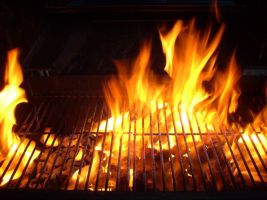Disposing of BBQ coals and ashes safely
June 6, 2022

If you use a charcoal BBQ or a fire pit, disposing of the ash can be a headache.
Nobody wants a bin fire outside their home. Likewise, it’s sensible to avoid setting fire to the waste collection vehicle that serves your area or the local tip (Recycling and Household Waste Site). However, with a bit of planning your used ashes can be disposed of safely and with minimal waste, and can even benefit your garden soil.
Before you cook:
- Avoid disposable barbecues if possible – As with many single use products, they offer convenience but at the cost of the planet. Disposable barbecues can’t be recycled and manufacturers also recommend that they aren’t reused / refilled with fresh coal either.
- Use a good quality untreated charcoal on your grill. Ash from untreated charcoal can be used in your garden. Treated charcoal (typically sold as ‘easy to light’) ashes shouldn’t be used in your garden as they can be toxic. The ash from treated charcoal will need to be extinguished, cooled and disposed of in your rubbish bin (i.e. sent to landfill).
- Use the minimum amount of charcoal possible. This saves money and reduces waste. Always follow any manufacturer’s instructions that came with your BBQ, but typically a 2 inch / 5cm layer of charcoal in the bottom of your grill is more than enough.
- Do not BBQ in parks, fields, woodland or moors. Don’t place your barbecue near anything in your garden that might melt or catch fire, avoid; fences, sheds, dry grass, trees and shrubs, plastic garden furniture and wheelie bins.
- Keep a bucket of water or sand nearby while cooking – just in case you need to put out a BBQ fire quickly, and never leave a BBQ unattended while cooking.
What to do with used charcoal (ashes)
1) Extinguish and cool your charcoal / ashes
If you have a BBQ grill with a lid and vents close them when you have finished cooking to starve the coals of oxygen. Doing so also reduces the chance of a coal or ember escaping while you wait for the coals to extinguish. Starving the coals of oxygen increases the chance of leaving unused charcoal in the bottom of your grill which can be used the next time you cook. If you try this, make sure you remove as much of the ash as possible from the leftover charcoal. Keep the leftover / partially burnt charcoal in the bottom of the grill dry until you are ready to reuse it. When you are ready to cook again spread a layer of fresh charcoal on top and use as normal.
If you don’t have a lid or vents or you are using a disposable barbecue, either let it burn out (this can take several hours) or extinguish it using sand or water. Keep in mind that unused coals that have been soaked in water will be extremely difficult to relight / reuse so you may be better off disposing of them rather than trying to reuse.
If you do extinguish your BBQ, please let everything cool down before you attempt to move it or dispose of it. You can still be burned by hot water or sand. Smouldering coals and hot ashes can also set fire to items in your bin or in a waste collection vehicle. If you are transporting your ashes / coals to a Recycling and Household Waste Site you don’t want to risk setting fire to your vehicle en route, or to the skips / bins at the site.
It’s recommended that you leave 48hrs to allow the ashes / embers from a BBQ / fire pit to cool down completely. Even then, be cautious when disturbing the ashes as doing so can introduce oxygen and reignite smoldering coals which in turn may set fire to materials nearby or in your bin, or simply melt your bin. Carefully rake through the ashes to check for smoldering and to help release residual heat. If in any doubt, douse them with water and or sand before moving them.
2) Dispose of the waste
If you don’t have a use for your ashes (see below) these should be placed in the rubbish bin. Make sure they are completely cold before moving them. If you use something to transport the ashes to your bin – please make the effort to use something reusable, or if you are going to throw your ashes away in a container or bag please use a non-recyclable item.
If you are transporting your waste to a Recycling and Household Waste Site, please take extra care to ensure everything is extinguished and cool before placing the items in your vehicle. Once on site you’ll be asked to dispose of the waste in a bin or skip for residual / non-recyclable general waste.
Uses for BBQ ash in your garden / allotment
- Fertiliser: Ash from additive-free wood charcoal contains a lot of potash (potassium carbonate) which is nutritious for many plants. Potash can change the pH of your soil making it more alkaline, so be cautious with its use. Don’t use charcoal ash with acid-loving plants (e.g. azaleas and hydrangeas). Newly planted seedlings and seeds don’t like potash either.
- Deter Pests: Some gardeners use charcoal ash as part of a home-made pest deterrent spray. Mix about 30g of ash and 30g of calcium hydroxide (also called: slaked lime, hydrated lime, caustic lime, and builders’ lime) to 4 litres of water. Spray the mixture around the plants you want to protect.
Uses for unused charcoal
If you have a bag of unused charcoal sitting round that you aren’t going to barbecue with, disposing of it in the rubbish bin is your last resort. If you can’t give it away it could also be used to:
- Reduce Odours: Unused charcoal is great at absorbing odours. Place a handful of charcoal in a cloth bag (or a clean sock) and keep it in your fridge or freezer to absorb food smells. It should also work with stinky shoes and trainers.
- Compost It: Adding the odd piece of unused charcoal to your compost heap will add carbon, which is vital to the composting process (charcoal is a ‘brown’ material). However, don’t be tempted to add more than a handful to your compost bin at a time. Any charcoal that ends up in your soil undecomposed can act to restrict the growth of your plants. In fact, powdered charcoal can be used to suppress the growth of weeds.
- Make cut flowers last longer: Adding one small piece of charcoal to the water of cut flowers is said to make them last longer.
If you have a BBQ/patio heater gas bottle or cylinder to dispose of, visit our ‘disposing of gas canisters safely’ page to find out more.










